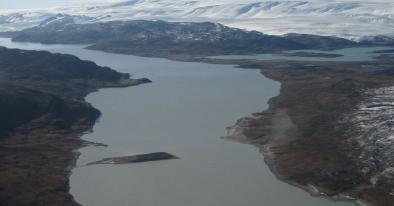Science Source
The darkening of the Greenland ice sheet: trends, drivers, and projections (1981–2100)
- States that the surface energy balance and meltwater production of the Greenland ice sheet (GrIS) are modulated by snow and ice albedo through the amount of absorbed solar radiation
- Shows, using space-borne multispectral data collected during the 3 decades from 1981 to 2012, that summertime surface albedo over the GrIS decreased at a statistically significant (99 %) rate of 0.02 decade−1 between 1996 and 2012
- Finds that, over the same period, albedo modelled by the Modèle Atmosphérique Régionale (MAR) also shows a decrease, though at a lower rate ( ∼ −0.01 decade−1) than that obtained from space-borne data
- Suggests that the discrepancy between modelled and measured albedo trends can be explained by the absence in the model of processes associated with the presence of light-absorbing impurities
- States the negative trend in observed albedo is confined to the regions of the GrIS that undergo melting in summer, with the dry-snow zone showing no trend
- Finds the period 1981–1996 also showed no statistically significant trend over the whole GrIS
- Finds that the observed albedo decrease is attributable to the combined effects of increased near-surface air temperatures, which enhanced melt and promoted growth in snow grain size and the expansion of bare ice areas, and to trends in light-absorbing impurities (LAI) on the snow and ice surfaces
- Finds that the apparent increase of LAI in snow and ice might be related to the exposure of a "dark band" of dirty ice and to increased consolidation of LAI at the surface with melt, not to increased aerosol deposition
- Finds that albedo projections through to the end of the century under different warming scenarios consistently point to continued darkening, with albedo anomalies averaged over the whole ice sheet lower by 0.08 in 2100 than in 2000, driven solely by a warming climate
Related Content
Science Source
| Geophysical Research Letters
Melting glaciers stimulate large summer phytoplankton blooms in southwest Greenland waters
Kevin R. Arrigo, Gert L. van Dijken, Renato M. Castelao et al
Science Source
| Geophysical Research Letters
Ice Core Records of West Greenland Melt and Climate Forcing
K. A. Graeter, E. C. Osterberg, D. G. Ferris et al
Science Source
| Science Advances
Abrupt shift in the observed runoff from the southwestern Greenland ice sheet
Andreas P. Ahlstrøm, Dorthe Petersen, Peter L. Langen et al
Headline

Dec 15, 2017 | Vox
Greenland's ice sheet is driving global sea level rise. One section is melting 80% faster.


